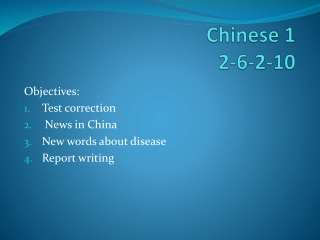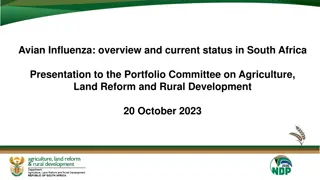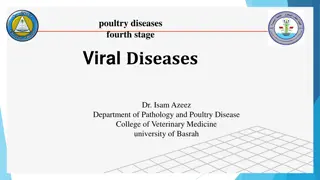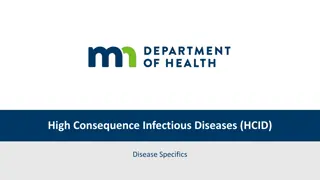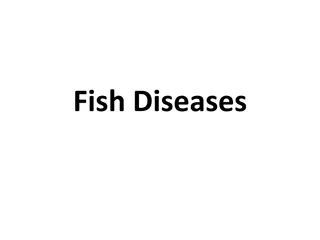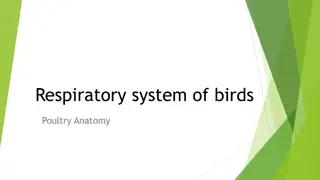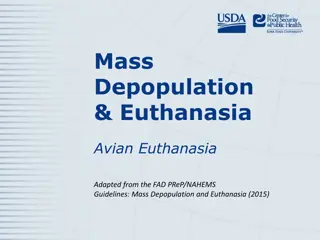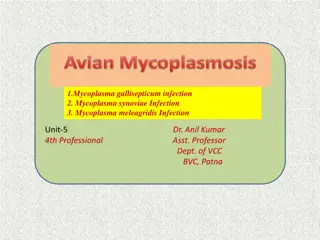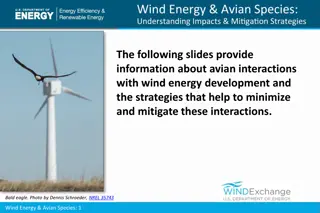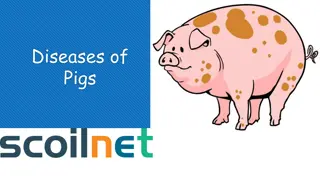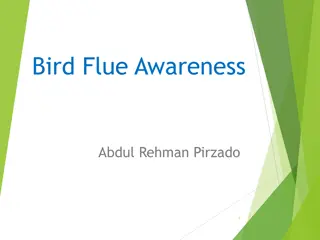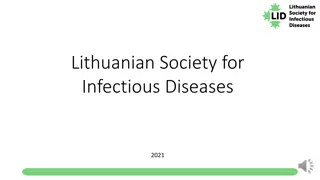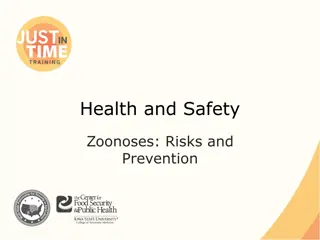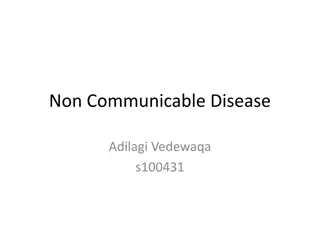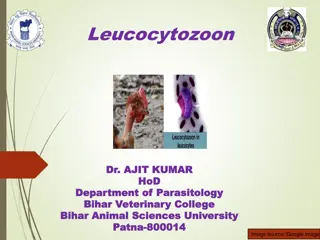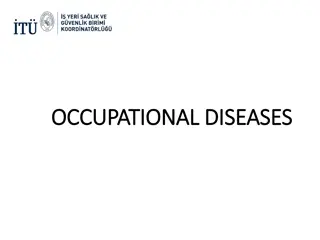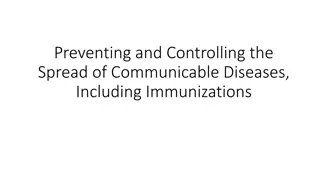Avian Hazard Advisory System (AHAS) Update
The latest updates to the Avian Hazard Advisory System (AHAS) providing crucial bird hazard information for flight safety. Learn about calculating NEXRAD risk, regional mosaics, flying areas, and risk management.
0 views • 23 slides
Study Materials for Learning about Diseases and Telling Time
Dive into a collection of study resources covering test corrections, news updates from China, new vocabulary related to diseases, and report writing tasks. Explore new words, grammar rules for telling time, and objectives for each day of the week. Get insights on recent developments in China, includ
0 views • 13 slides
Impact of Highly Pathogenic Avian Influenza 2023 on South African Broiler Industry
The presentation by the South African Poultry Association sheds light on the detrimental effects of Highly Pathogenic Avian Influenza (HPAI) on the broiler industry in South Africa. Factors such as load shedding, water supply interruptions, and now, the outbreak of H7N6, have exacerbated the financi
4 views • 19 slides
Avian Influenza Overview and Outbreak History in South Africa
Avian Influenza, specifically Highly Pathogenic Avian Influenza (HPAI) outbreaks in South Africa, have been documented since 2004, affecting primarily ostriches and poultry. Wild bird transmission remains a concern, with risk factors such as rainfall, temperature, wetlands, and poultry movements con
2 views • 25 slides
Overview of Poultry Diseases and their Causes
Poultry diseases caused by viruses and bacteria are a significant concern for poultry farmers. Viral diseases like Ranikhet Disease, Fowl Pox, and Avian Leucosis can have high mortality rates and severe symptoms. Bacterial diseases such as Tick Fever, Tuberculosis, Fowl Cholera, and Infectious Coryz
2 views • 12 slides
Periodontal Treatment Considerations for Medically Compromised Patients
Patients with significant medical conditions may require special considerations for periodontal treatment. Medical issues such as hemorrhagic disorders, renal diseases, liver diseases, pulmonary diseases, infectious diseases, pregnancy, medications, and cancer therapies can impact oral health and tr
1 views • 87 slides
Understanding Viral Diseases in Poultry: Newcastle Disease and Avian Influenza
Viral diseases like Newcastle Disease (ND) and Avian Influenza (AI) pose significant threats to poultry farming, impacting bird health and production. ND, caused by Avian paramyxovirus type 1, is highly contagious and manifests in various forms affecting birds' respiratory and nervous systems. On th
7 views • 24 slides
Best Neurosurgery Hospitals in India
Neuro diseases are very bad diseases. Many people are caught by Neuro diseases nowadays. It is related to brain diseases. Many people in India are caught by Neuro Diseases. It happens in Adults as well as children.\nA person of any age can be affected by this. Before this time very bad disease Named
1 views • 2 slides
Update on Avian Influenza A(H5N1) Outbreak in the U.S.
Avian Influenza A(H5N1) has been detected in domestic livestock and a few human cases have been reported in the U.S. The CDC issued a technical report detailing the cases and their symptoms. No human-to-human transmission has been identified so far. The situation is being closely monitored and updat
0 views • 17 slides
Overview of Nutritional Diseases and Disorders
Nutritional diseases arise from imbalances between the body's nutrient and energy requirements and their supply. Nutritional deficiencies can lead to clinical diseases, while excessive intake can result in diseases of affluence. Common nutritional disorders include low birth weight, PEM, obesity, go
4 views • 6 slides
Neonatal Diseases
Neonatal and postnatal diseases in livestock, with a focus on perinatal, neonatal, and postnatal stages. It covers common classifications, causes, and risk factors associated with these diseases, particularly focusing on neonatal diarrhea (Calf Scour). The content delves into noninfectious and infec
0 views • 33 slides
Understanding Fungal and Protist Diseases: Impacts and Prevention
Fungi and protists play significant roles as pathogens, causing diseases in both humans and plants. Fungal diseases like athletes foot and protist diseases like malaria can have serious impacts on health. Control measures such as understanding symptoms, spread mechanisms, and prevention strategies a
0 views • 10 slides
Overview of Clostridial Diseases Caused by Clostridium Bacteria
Clostridial diseases are caused by bacteria of the genus Clostridium, which are anaerobes commonly found in soil, feces, and healthy animal tissues. These bacteria can lead to various diseases in animals such as black quarter, gas gangrene, necrotic dermatitis, and more. Understanding the different
0 views • 55 slides
Managing Nutritional and Metabolic Diseases in Zoo and Wild Animals
The prevention, control, and treatment of nutritional and metabolic diseases in zoo and wild animals are essential for maintaining their health. These diseases, such as rickets, osteoporosis, osteomalacia, and fibrous osteodystrophy, can result from imbalances in dietary nutrients and metabolic dera
0 views • 10 slides
Understanding High Consequence Infectious Diseases (HCID)
High Consequence Infectious Diseases (HCID) encompass serious illnesses like Middle East Respiratory Syndrome (MERS), Ebola Virus Disease (EVD), and more. Patient screening for symptoms is crucial, and HCID is defined as diseases with high mortality rates and potential risks to healthcare personnel.
0 views • 70 slides
Understanding Fish Diseases and Health
Fish diseases and health are essential aspects of aquatic life. Diseases can be infectious or non-infectious, causing impairments to the normal state of fishes. Recognizing symptoms and signs of diseases is crucial for diagnosis and treatment. Overall, maintaining the health of fishes is vital for t
0 views • 21 slides
Anatomy of the Respiratory System in Birds: A Detailed Overview
The respiratory system in birds, including poultry, consists of various components such as nostrils, nasal cavities, larynx, trachea, syrinx, air sacs, and lungs. Each part plays a crucial role in respiration, with unique features adapted to avian physiology. Understanding the anatomy of the avian r
0 views • 19 slides
Infectious Diseases 4/5th Semester Classes: Approach & Prevention
Infectious Diseases class focuses on various topics including Antibiotic Stewardship Practices, Community-Acquired Infections, Gram-Positive and Gram-Negative Bacteria, Spirochetal Diseases, Diseases Caused by Bacterial and Viral Infections, HIV/AIDS, Fungal and Parasitic Infections. The class also
3 views • 30 slides
Zoonotic Diseases in Mongolia: A One Health Perspective
High risk of zoonosis in Mongolia is evident due to various factors such as livestock practices, wildlife diseases, and environmental changes. The National Center for Zoonotic Diseases in Mongolia plays a crucial role in studying, preventing, and raising awareness about over 160 zoonotic infectious
0 views • 13 slides
Guidelines for Avian Euthanasia and Mass Depopulation
Avian euthanasia and mass depopulation are crucial processes in animal health emergencies. This involves transitioning animals painlessly, maintaining welfare, and preventing disease spread. Methods such as injectables, inhalants, and physical methods are utilized, all aiming to provide a humane and
0 views • 22 slides
Overview of Pathogenesis in Infectious Diseases
This content provides valuable information on the pathogenesis of infectious diseases, including definitions, phases of disease progression, types of infections, acute vs. chronic diseases, signs vs. symptoms, steps in pathogenesis, and ways pathogens can enter the body. It discusses the importance
0 views • 15 slides
Understanding Mycoplasma Infections in Avian Species
Mycoplasma infections, caused by species like Mycoplasma gallisepticum and Mycoplasma synoviae, are common in poultry, particularly affecting turkeys and chickens. These infections lead to respiratory issues, sinusitis, and reduced production rates. Learn about transmission, clinical findings, and v
0 views • 13 slides
Avian Interactions with Wind Energy Development
The slides discuss avian interactions with wind energy development, highlighting challenges faced by bird species due to climate change. Strategies to minimize these interactions are explored, emphasizing the environmental benefits of wind energy and comparing avian fatality rates with other enginee
0 views • 19 slides
Managing and Preventing Diseases in Pig Farming
Proper temperature regulation, ventilation, hygiene practices, and feeding are essential in reducing the risk of diseases among pigs. Indoor farming allows control over these factors but also poses a challenge if diseases do occur, potentially leading to rapid spread and significant economic losses
0 views • 8 slides
Understanding Avian Influenza: Symptoms, Diagnosis, and Prevention
Avian influenza, or bird flu, is a viral disease affecting birds' respiratory, digestive, and nervous systems. It presents in two forms - Highly Pathogenic Avian Influenza Virus (HPAIV) and Low Pathogenic Avian Influenza Virus (LPAIV). The virus has two important surface antigens, Hemagglutinin (H)
0 views • 7 slides
Understanding Avian Influenza: Symptoms, Transmission, and Prevention
Avian influenza, commonly known as bird flu, is a contagious disease caused by flu viruses that primarily affect birds but can also spread to humans. Learn about the symptoms in humans, how the virus spreads, and preventive measures to stay safe. Stay informed and take necessary precautions to reduc
0 views • 15 slides
Common Regulated Diseases in Imported Fruit and Vegetables
Imported fruit and vegetables can carry regulated diseases such as Citrus Black Spot, Citrus Scab, and Citrus Canker. These diseases affect citrus fruits and peppers, causing scabs, spots, and cankers, making the produce unmarketable. The pathogens causing these diseases have been intercepted in imp
0 views • 12 slides
Understanding Prion Diseases: A Comprehensive Overview
Prion diseases, such as Transmissible Spongiform Encephalopathies (TSEs), are rare and fatal neurological disorders affecting both humans and animals. These diseases are characterized by long incubation periods, neuronal loss, and the absence of an inflammatory response. Caused by abnormal folding o
0 views • 12 slides
Birds of Girinagara: A Study on Avian Species and Habitats
Documenting and analyzing the bird life in Girinagara, this study captures various species such as Pale Billed Flowerpecker and Red Whiskered Bulbul. With detailed observations of their activities and habitats, the research sheds light on the rich avian diversity present in the area.
0 views • 11 slides
Lithuanian Society for Infectious Diseases: Advancing Infectious Diseases Diagnostics, Treatment, and Prevention
Lithuanian Society for Infectious Diseases is a non-profit organization in Lithuania that brings together healthcare professionals to improve the diagnosis, treatment, and prevention of infectious diseases. They participate in various initiatives, events, and collaborations, organize conferences, an
0 views • 7 slides
Understanding Infectious Diseases: Approach, Prevention, and Viral Agents
Infectious diseases play a significant role in public health, with a focus on antibiotic stewardship, community-acquired and healthcare-associated infections, as well as various bacterial, viral, fungal, and parasitic agents. Specific topics include the prevention of infectious diseases, with a deta
0 views • 18 slides
Understanding Zoonotic Diseases and Prevention Strategies
Zoonotic diseases pose a risk as they can be transmitted from animals to humans under natural conditions. Awareness of transmission routes is crucial. Direct contact, ingestion, aerosol, and indirect transmission through fomites or vectors are common means of spreading these diseases. Animals may no
0 views • 15 slides
Managing Non-Communicable Diseases: Role of Health Care Providers
Non-communicable diseases (NCDs) like cardiovascular diseases, cancers, chronic respiratory diseases, and diabetes mellitus pose significant health challenges globally. This overview delves into the definition, epidemiology, and management strategies of NCDs, emphasizing the critical role of health
0 views • 18 slides
Understanding Non-Communicable Diseases and Global Action Plans
Non-communicable diseases (NCDs), such as cardiovascular diseases, cancers, chronic respiratory diseases, and diabetes, pose a major health threat globally, with 38 million deaths yearly. The Global Action Plan aims to reduce premature mortality from NCDs by 2025 through specific targets, including
0 views • 16 slides
Leucocytozoon: Haemoparasite in Birds from Bihar Animal Sciences University
Leucocytozoon, a haemoparasite found in birds, is studied at Bihar Animal Sciences University under Dr. Ajit Kumar. The parasite's morphology, life cycle, and host interactions are detailed, providing valuable insights into its impact on avian health. The research sheds light on the genus Leucocytoz
0 views • 13 slides
Understanding Infectious Diseases and Prevention Strategies
Infectious diseases are caused by pathogens like bacteria, viruses, parasites, or fungi invading the body. These diseases can spread from person to person and sometimes from animals to humans. Common characteristics include potential severe outcomes, transmission modes, and the role of pathogens. Th
0 views • 27 slides
Respiratory Diseases in Cattle: Causes, Infections, and Management
Respiratory diseases in cattle primarily stem from infectious agents such as infectious bovine rhinotracheitis and Pasteurella spp. These diseases compromise the defense mechanisms of the body, leading to infections like pneumonia and pleuropneumonia. Viruses, mycoplasmas, and bacteria like Histophi
0 views • 31 slides
Understanding Occupational Diseases and Prevention Methods
This detailed training covers basic concepts of occupational diseases, types, diagnostic methods, protection measures, statistics, and legal procedures. It emphasizes the preventable nature of occupational diseases and the importance of legal responsibilities. The visuals and statistics presented hi
0 views • 49 slides
Understanding and Preventing Communicable Diseases
Communicable diseases, also known as contagious or infectious diseases, are caused by germs such as viruses, bacteria, fungi, and parasites. These illnesses spread from person to person through various means like body fluids and can have different treatment approaches. It is essential to know how th
0 views • 34 slides
Understanding Influenza: From Pandemics to Avian Flu Outbreaks
Influenza is a viral respiratory illness that can range from seasonal flu to pandemic outbreaks like the 2009 swine flu (H1N1) epidemic. The dangers and prevention methods of specific strains, such as H5N1 avian flu, have been witnessed since 2003. This summary delves into the characteristics, impac
0 views • 13 slides

